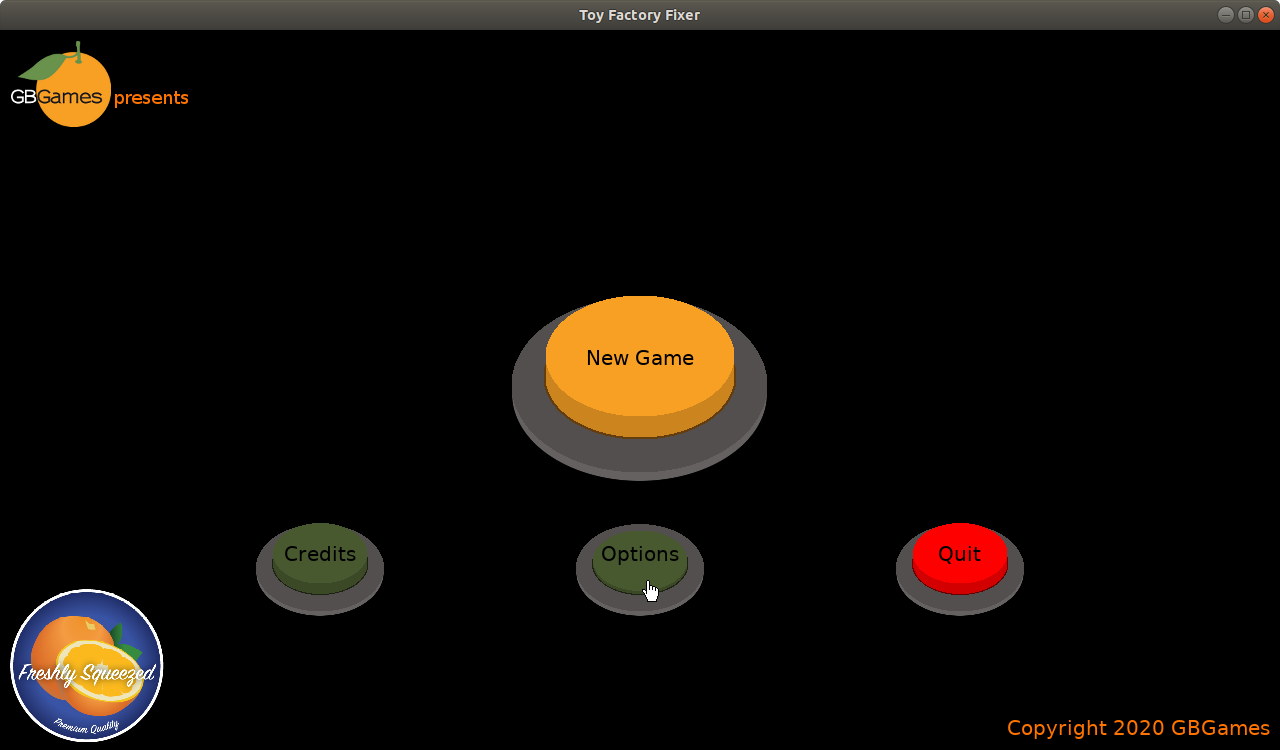In my last report, I talked about my plans for creating and releasing games for free as Freshly Squeezed Entertainment. Toy Factory Fixer is my first Freshly Squeezed Project.
Creating the Project
Historically, I’ve created new projects by using the code of older projects, removing the game-specific code, art, and sound so I can start with a clean but strong base. This project was no exception, but I found that it took me quite a bit of work to take Toytles: Leaf Raking‘s source and remove all things toytles-related.
I made a note to myself that if I am going to be doing this reuse regularly, I need to make it easier by separating the generic code from the game-specific code.
During One Game Per Month in 2013, I did do something like that, but at the time I just deleted one file because I threw all the game-specific code into it. It’s not maintainable, and I know, because Toytles: Leaf Raking started life like that before I started splitting out to make it easier to work with, but for a one month project that I wasn’t intending to return to, it worked fine.
So I want to do something similar by setting up a separate game-specific directory for game-specific code, so that way I just delete that directory’s contents and have a new project ready to go.
Anyway, once I had the new project building and running, all it had was a main menu on a blank title screen. I created a quick button, and I updated some of my generic code to render buttons with an arbitrary color, and here’s the result:
I know the menu isn’t exciting, but much like my One Game Per Month games, I want the main menu screen to be fairly standard and easy for me to build. I am already mimicking what Toytles: Leaf Raking does in terms of which buttons are available and what happens when you press them. I am hoping that aside from swapping out the game’s title and background art, perhaps even the button art, the menu requires no work to reuse for future projects.
I realized that I now have a project to work on, but I didn’t put together a a plan to work on it yet. I know some people like to use simple TODO items in a list, but I actually find it helpful to have a spreadsheet tracking not only my backlog of features, ideas, and defects, but also what I plan to work on in a given week. I think even for a small project, and maybe especially for a small project, having a project plan with a more robust sense of what I am doing and when I plan to do it. It helps to keep me from working too long on one aspect of the project and reminds me that I want to ship a working project.
If you’re interested in reading how I do it, I documented how I go about creating my game development project plans back in 2016. I do mostly the same thing today, although I found it easier to not split up the user story across multiple cells. Copying a single cell and putting it into my sprint plan is easier than trying to take multiple cells and adding the text from the column headings so it makes a complete sentence. Perhaps it might be easier still to have the cell get populated based on a user story ID so I don’t have to manually copy the text, but it’s not too big of a pain for me to worry about fixing.
So now I have a simple project plan with a simple backlog that I expect to grow as I work on the project and think of ideas or identify work that needs to be done.
Yet it’s a plan that is detailed enough to keep me focused on getting a shippable game as quickly as possible.
What’s Next?
One thing I didn’t anticipate that I should have is that the holidays are here, and I might have less than the 5 hours of week I average on game development due to working on house projects, doing Christmas shopping online, and making sure our address book is up-to-date so we know where to send our annual Christmas card.
So while my goal is to get the game out before Christmas, it is entirely possible that I won’t find myself with nearly as much time to work on it as I’ll need to do so. I know that at least the App Store is saying that they won’t review games around Christmas, so there’s a bit of a deadline if I want it out in time.
But this project is also a good first attempt to see how long it will take me to get a brand new game design into the hands of players. Some of my One Game Per Month games only took me a handful of hours to put together, so perhaps I’ll find that this game will come together much more quickly than I anticipate.
But I am also figuring out a number of things, such as what resolution should the game run at “natively” or how big should the factory floor be in terms of tiles or how the HUD and interface should look. It should be fun. B-)
Thanks for reading!
—
Want to learn when I release updates to Toytles: Leaf Raking or about future Freshly Squeezed games I am creating? Sign up for the GBGames Curiosities newsletter, and get the 24-page, full color PDF of the Toytles: Leaf Raking Player’s Guide for free!


One reply on “Freshly Squeezed Progress Report – Toy Factory Fixer”
[…] Last week’s report focused on what it took to get a new project started, especially when this project will be the first in a line of Freshly Squeezed projects. […]